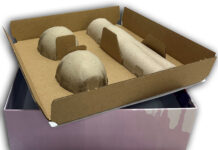SMITHFIELD Murray has installed two Ishida IX-G2 X-ray poultry solutions to detect and remove bone and cartilage from its products.
A supplier of prepared fresh and frozen poultry, Smithfield Murray handles around 250 tonnes of meat each week, which is ultimately supplied to retailers and food service companies including major supermarkets.
The dedicated Ishida X-ray inspection systems for poultry were installed at the firm’s BRC Grade AA plant in Manchester. The investment in X-ray inspection technology supports the company’s drive to be, as MD Damien Murray put it, ‘the best in the world at what we do’.
The two IX-G2 models use dual energy technology, which incorporates two-line sensors, one which takes images at high energy and one at low energy. These are compared, which Ishida said provides a better overall image of the product with a clearer contrast between the product and low-density foreign bodies, such as bone fragments. Should any foreign body be identified, it is rejected and returned for re-trimming.
Ishida added that dual energy X-ray inspection is particularly appropriate for the poultry industry as the density of product and potential contamination can be very similar, for example the bone and meat of a chicken which have almost the same density. Removal of low-density foreign bodies, such as bone and cartilage, is essential as the majority of products need to be supplied boneless for use in recipes.
“Consumer expectation is that meat is boneless, but due to the relatively young age of many chickens at slaughter, their bone development isn’t at full density,” said Smithfield Murray’s operational production manager, Pawel Charazmusiewicz. “This can leave cartilage or soft bone fragments in the meat, which we need to remove before supplying product to our customers.”
Previously, the company’s foreign body inspection process was manual, with an initial check during trimming and a more thorough search further down the line. This was time-consuming and exposed the meat to several stages of manual handling.
Smithfield Murray knew there was a better way of doing things but required a solution that would fit the compact footprint at its site. The answer came via one of the company’s industry peers, which was already using the Ishida IX-G2.
“Our view is there’s no downside to sharing best practice in the industry,” said operational technical manager David Hrubos. “If it makes better product and improves standards for everybody, there’s a responsibility to look out for each other.”
MD Damien Murray added, “We’re a work family – and often, a literal one, too. We have plenty of husbands and wives, or fathers and sons, working together in the factory. This has been particularly true since Covid-19, when we stopped using agency staff and realised that morale, dedication, and quality improved because our permanent staff really take pride in what they do.
“This has a bearing on the Ishida machines, because it’s important that anything we invest in is well maintained and cared for. David and Pawel led a very close-knit team running them, who take real ownership and responsibility for the X-ray machines. You might say the Ishida machines have become part of the family!”
The IX-G2 models used at Smithfield Murray are the dual lane variant, giving throughputs in excess of 100 fillets per lane. The first Ishida X-ray poultry solution was installed in in the primary preparation area, where chicken is trimmed for use in children’s meals.
The second IX-G2 formed part of a new ‘Opti’ line, which was configured with the anticipation of an X-ray machine being included. Therefore, installation had to be ‘plug-and-play’.
Damien Murray believes the investment has been money well spent. “I wouldn’t hesitate to recommend Ishida to other companies in our sector,” he stated. “The value their X-ray machines are adding to our operation has been significant, and they’ve been a joy to work with.”















